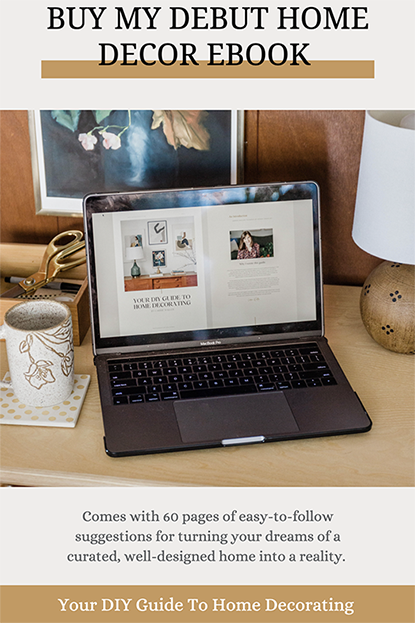.jpg)
Back in April when I visited High Point Market, I ended up falling in love with a piece of framed textile art in one of the showrooms that I visited. I decided to splurge for myself and special-ordered the piece to showcase later here on the blog and in our home. Several weeks later, the wall art arrived packaged extra carefully, and I was giddy to tear into it. Alas, once I got all of the wrapping off, I realized that the custom frame wasn’t what I had originally ordered. I had wanted the textile art finished with a natural wood frame, but received a desaturated metallic brass frame instead.
.jpg)
.jpg)
.jpg)
The metallic frame was pretty and complemented the art itself nicely, but it wasn’t what I had in mind and didn’t match anything else in our guest room, which is where I wanted to hang it. I have a number of other wood-framed pieces of art in this space, and I wanted all of the art pieces to feel cohesive with lighter-tone frames. After reaching out to the company to discuss return options, we ultimately agreed on a partial refund, and I opted to keep the framed art. Once that was all settled, I got to work brainstorming how to fix the frame so that it matched my ultimate design vision.
.jpg)
.jpg)
.jpg)
As you likely already know from reading today’s post title, I turned to Rub ‘n Buff for my frame fix! I happened to have a years-old tube of “Antique Gold” Rub ‘n Buff in my craft supply closet, so this fix didn’t cost anything at all. I’ve always heard such amazing things about Rub ‘n Buff, so that’s why I bought some so many years ago. I just never had the specific need to use it—until now, of course. I’m so glad that I had the foresight to stockpile this kind of gilding wax because it was such a simple process to go from “idea” to “action.” I ran right downstairs to my crafting storage area, grabbed what I needed (Rub ‘n Buff, painter’s tape, scrap cardboard, and an old rag), then ran back up to get to work immediately on my frame.
.jpg)
.jpg)
The steps for this were really simple. I stuck down lengths of painter’s tape all along the art work’s glass where it met with the edge of the frame, then I placed the whole thing over scrap cardboard to protect our floors and rug from the colored wax. After that, I used my rag to buff the wax over top of the old metallic finish of the frame (a little goes a long way, just so you know!). In case you’re wondering, I didn’t sand the frame or anything first—I just rubbed the wax right over the frame, from top to bottom. I did one coat and then went quickly back over any areas that I felt needed a little more coverage. Since the frame was already a metallic sheen beneath, the two tones blended well with one another, so I didn’t do a second coat. After letting it dry overnight, I hung the finished art piece up on the wall.
By the way, I was asked on Instagram when I shared a video of this project if any of the wax came off on my fingers the next day, and the answer is nope! It’s a totally cured finish that seems to be staying in place well so far.
.jpg)
.jpg)
I did want to mention that, despite my best efforts with painter’s tape, some of the wax ended up on the front-facing glass of the art piece. I initially tried to wipe those smudges off with a clean fingertip, but the waxy texture meant that the smudge just moved around on the glass without lifting. So, instead, I grabbed my trusty bottle of Contractor’s Solvent, sprayed a bit onto a clean paper towel, and gently rubbed the smudges off the glass. This Solvent is awesome for getting sticky, waxy things off solid surfaces, like glass, ceramics, and metal. I use it all the time to get rid of price stickers on new purchases! Anyway, I wanted to mention that tip in case you end up with unwanted smudges from the Rub ‘n Buff on your art piece. Just be careful not to get the Solvent on your freshly waxed frame as it will probably take the finish off where you don’t want to.
.jpg)
.jpg)
.jpg)
.jpg)
.jpg)
I think the new gold finish looks so much brighter than the old brass frame did (before/after a couple of photos above for comparison), and even though it’s not the true wood frame I was hoping for, I think the lighter gold color is pretty darn close. I’m glad that I didn’t have to send the art back or have to get it reframed. Do you see how well the new gold frame matches the bright metallic fibers in the art below? Maybe it was all meant to be…Have you used Rub ‘n Buff before? It seems to be especially good for fixing frames, but I’m curious what other projects you guys have used it on. Comment below and share your DIY details!
.jpg)
*This post contains affiliate links, which means that I may earn a small commission when you purchase products that I recommend at no additional cost to you. This allows me to provide free creative content for you to read, save, and share. Rest assured that I never recommend products we wouldn’t use or don’t already love ourselves.

.png)
.jpg)
.jpg)
.jpg)
.jpg)
.jpg)
.jpg)
.jpg)
.jpg)
.jpg)
.jpg)



